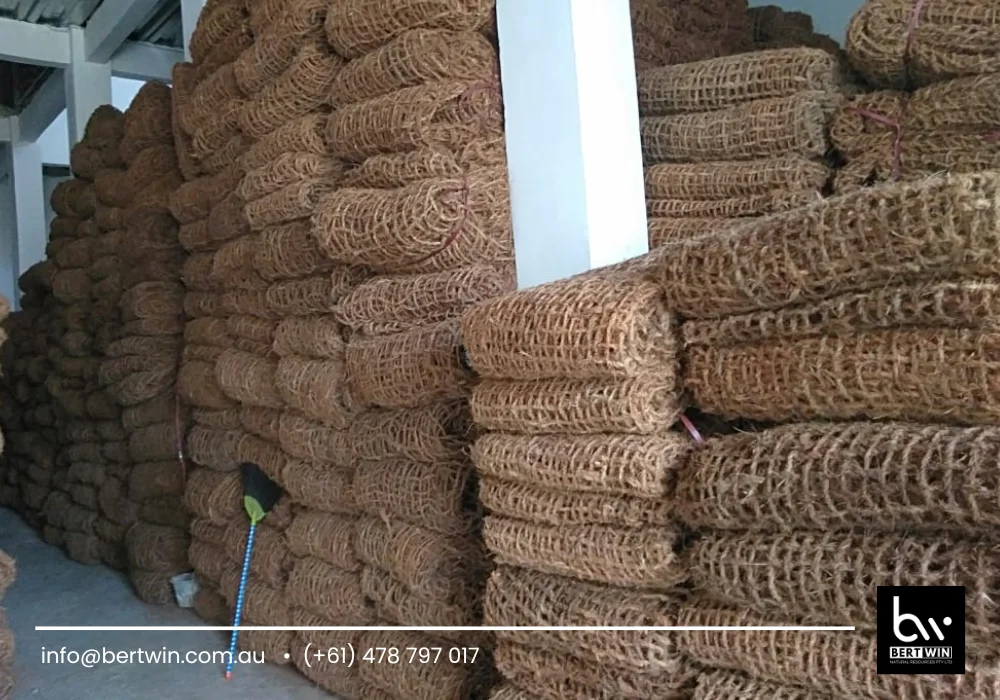When it comes to landscaping, erosion control, and various construction projects, coco mesh for projects is quickly becoming a preferred solution. Made from natural coconut fibers, coco mesh is a biodegradable, environmentally friendly material that can be used in a wide range of applications. In this article, we will explore the benefits of using coco mesh for projects, its different uses, and why it is a reliable choice for sustainable construction and landscaping efforts.

What is Coco Mesh for Projects?
Coco mesh for projects is a biodegradable material made from coconut fibers that are woven together to create a mesh fabric. It is typically used for landscaping, erosion control, soil stabilization, and even as a protective covering for various surfaces. The unique structure of the mesh allows it to be highly durable, while also being eco-friendly and sustainable. It is often used in large-scale projects like slope stabilization, landscaping, and as a protective layer for soil, plants, and seeds.
Key Benefits of Using Coco Mesh for Projects
1. Environmentally Friendly and Sustainable
One of the most significant advantages of coco mesh for projects is that it is made from 100% natural, renewable resources. Unlike synthetic alternatives like plastic mesh or materials made from petroleum-based products, coco mesh is completely biodegradable. As it decomposes, it does not harm the environment but rather contributes organic material to the soil. This makes it an ideal choice for those looking to reduce their carbon footprint and choose more eco-conscious solutions for their projects.
2. Effective Erosion Control
Erosion can be a major issue, especially in areas with slopes, heavy rainfall, or wind. Coco mesh for projects is an effective solution for controlling erosion. It helps stabilize the soil by preventing it from washing away, especially in areas where the ground is prone to erosion. The mesh holds the soil in place and reduces the velocity of surface water runoff, making it particularly useful in construction and landscaping projects located on steep slopes or embankments.
3. Encourages Plant Growth
In addition to erosion control, coco mesh for projects can promote plant growth. It is often used in landscaping and gardening to create an ideal environment for seedlings and plants to thrive. By providing a protective layer over the soil, it helps retain moisture, reduces the growth of weeds, and protects plants from harsh weather conditions. Over time, as plants grow, the mesh breaks down naturally, enriching the soil and promoting healthy plant life.
4. Durability and Longevity
Another key benefit of using coco mesh for projects is its impressive durability. Unlike other biodegradable materials that may degrade quickly, coco mesh has a long lifespan, making it suitable for long-term use in erosion control and landscaping projects. Its fibrous texture allows it to withstand harsh weather conditions, including rain, wind, and even exposure to UV light, without deteriorating quickly. This makes it an excellent option for both short-term and long-term projects.
5. Cost-Effective and Easy to Use
Coco mesh is a cost-effective material for various projects. It is relatively inexpensive compared to other erosion control and landscaping materials, which can significantly reduce the overall project cost. Additionally, it is easy to install and handle, making it accessible for both professional landscapers and DIY enthusiasts. It can be cut to the desired size and applied directly to the project site without the need for specialized equipment.
Different Uses of Coco Mesh for Projects
1. Erosion Control on Slopes and Embankments
One of the primary uses of coco mesh for projects is for erosion control on slopes and embankments. By providing a protective layer that holds the soil in place, coco mesh prevents soil from washing away during heavy rains or floods. It also encourages the growth of vegetation, which further helps stabilize the slope over time. This application is especially valuable for projects involving roads, highways, or construction sites on hilly or uneven terrain.
2. Landscaping and Garden Projects
Coco mesh for projects is widely used in landscaping and garden designs. It helps create a stable environment for plants to grow by providing soil retention and moisture regulation. It can be used as a ground cover for garden beds, around trees, and on slopes to prevent soil erosion. In addition to protecting plants, coco mesh also helps control weeds and creates an aesthetically pleasing surface for outdoor spaces.
3. Green Roofing and Vegetated Roofs
Coco mesh is increasingly being used in green roofing projects, where it serves as a base for growing vegetation on rooftops. It provides a protective layer to hold soil in place and supports the growth of plants, which help insulate buildings and reduce energy consumption. This application of coco mesh for projects is an excellent example of how sustainable materials can contribute to eco-friendly building practices.
4. Soil Stabilization in Construction Projects
In construction, coco mesh for projects is used for soil stabilization. It is often applied in areas where soil needs reinforcement, such as in the construction of retaining walls, foundation stabilization, or road construction. The mesh helps bind the soil together and prevents shifting, ensuring the stability of the structures built on it. This is especially important in areas with loose or sandy soils.
How to Apply Coco Mesh for Projects
1. Prepare the Surface
Before applying coco mesh for projects, ensure that the surface is properly prepared. This may include clearing debris, weeds, and any loose soil. For erosion control, it is essential to smooth the surface and grade it correctly to ensure that the mesh will perform effectively.
2. Lay the Coco Mesh
Unroll the coco mesh and place it on the surface where it will be applied. For slope protection, make sure the mesh is laid evenly and securely fastened. You can use stakes or pins to anchor the mesh to the ground and prevent it from shifting or rolling away.
3. Cover with Soil or Mulch
Once the mesh is in place, it should be covered with a layer of soil, mulch, or another protective material. This will help hold the mesh in place and promote the growth of plants if necessary. The cover also prevents the mesh from being exposed to UV light, which can help extend its lifespan.
4. Monitor the Area
After installation, it is essential to monitor the area to ensure that the coco mesh is functioning correctly. In the case of erosion control, check for any signs of soil loss or instability. For landscaping projects, ensure that the plants are growing as expected and that the mesh is still in place.
Conclusion
Coco mesh for projects offers a sustainable, cost-effective, and versatile solution for a wide range of construction and landscaping needs. From erosion control on slopes to promoting plant growth in gardens, coco mesh provides numerous benefits. Its environmentally friendly properties, durability, and ease of use make it an excellent choice for any project that requires soil stabilization, erosion prevention, or landscaping enhancements.
For further information, you may contact WhatsApp at (+61) 478797017 or via email at info@bertwin.com.au.
